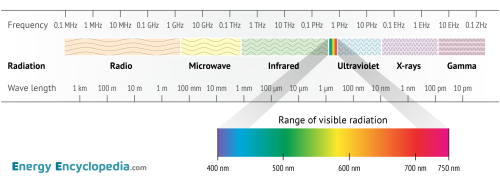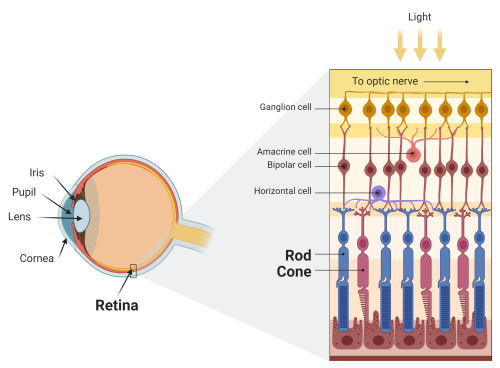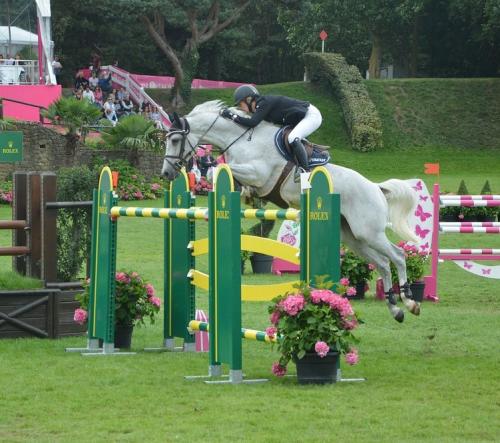Equine Vision and Performance
It can be frustrating when your horse spooks at something outside of the arena while you are going to the right, and then again to the left as if he’s never seen it before. Your horse is not trying to be difficult; he just sees things differently than you do. Whether heading to a jump, negotiating a turn to a barrel, or navigating the trail, aiming to understand how horses see the world can benefit their performance and welfare.
Horses’ large eyes are set wide apart on the sides of their heads, providing them with both monocular (each eye works independently and has different views) and binocular (both eyes overlap) vision. This enables them to see almost a full circle around themselves, minus blind spots directly in front of and behind them. With comparatively small eyes on the front of our heads, humans can see the world in a lot of detail, but only in small slices (about 45 degrees on each side of the nose). Horses have a much broader view (about 350 degrees), but likely in less detail. They generally have to be 50% closer to something to see it in the same level of detail.
Since horses cannot explain what or how they see, vision assessment is subjective and largely extrapolated from human ophthalmology. Three aspects of vision that are important to horse performance are light, color, and depth perception.
Light
The most basic aspect of vision is the ability to perceive light. Mammals can typically only detect a tiny portion of the electromagnetic spectrum - between approximately 400 and 750 nanometers. Even within this spectrum, not all photons are detected equally well, with significant variation from one individual to another.


The retina, a multi-layered tissue in the back of the eye, contains specific cells called photoreceptors - cones to see in bright light and rods for vision in dim light. Horses see well in dim light, and at night, since they have more rods in their eyes than humans, a greater proportion of rods to cones (20:1 in horses versus 9:1 in humans), and have a tapetum lucidum, a structure in the eye that increases light to photoreceptors.
However, horses may have difficulty transitioning quickly between brightly lit and dark locations. It takes their eyes about twice as long (approximately 45 minutes) to adjust than it takes ours (about 20 minutes). This can explain resistance to crossing visual barriers that go from light to dark, such as when entering trailers or stalls.
Think about this the next time you take your horse from sunlight into an indoor arena. Consider walking in the shade or standing at the in-gate for a while before entering to ease the transition.
Color

Horses can perceive color, but not in the same way that we do. The ability to perceive color is based on cone pigments. Horses, like other non-primate mammals, have two types of cone pigments (dichromatic), whereas humans have three
(trichromatic). Horses likely see hues similar to what we see as blue and yellow, but they cannot see red or shades of red. Behavioral studies have demonstrated that horses can distinguish blue and yellow from gray, whereas they are less accurate when it comes to differentiating green and red from gray. Practically, we can think of horses as having a form of red-green color-blindness. The color that horses likely see best is yellow.
Think about this the next time you ride in an arena with colored banners hanging on the rail. Your horse may be most likely to spook at the yellow one and ignore the red one (unless it is flapping).
Depth Perception
Depth perception relies on binocular vision. Whereas a horse’s monocular field of vision is very wide, the binocular field of vision is much smaller. Horses have a smaller field of depth perception than people do, meaning that they have a harder time determining relative distances. Humans have better depth perception because our eyes are close together. Since horses’ eyes are set far apart, in most instances they cannot see both the right and left eye views in one glance. They can improve their depth perception by raising their heads.
Think about this the next time you ask your horse to jump an obstacle. Allowing some freedom in movement of the head may improve their view.
Vision and Behavior
As with many other aspects of horse management, we often do not think in depth about our horses’ vision until there is a problem. A veterinarian may be called to examine a horse with new behavioral issues, such as excessive shying or head shaking, and find an ocular issue. Eye exams are an important part of routine veterinary care.
